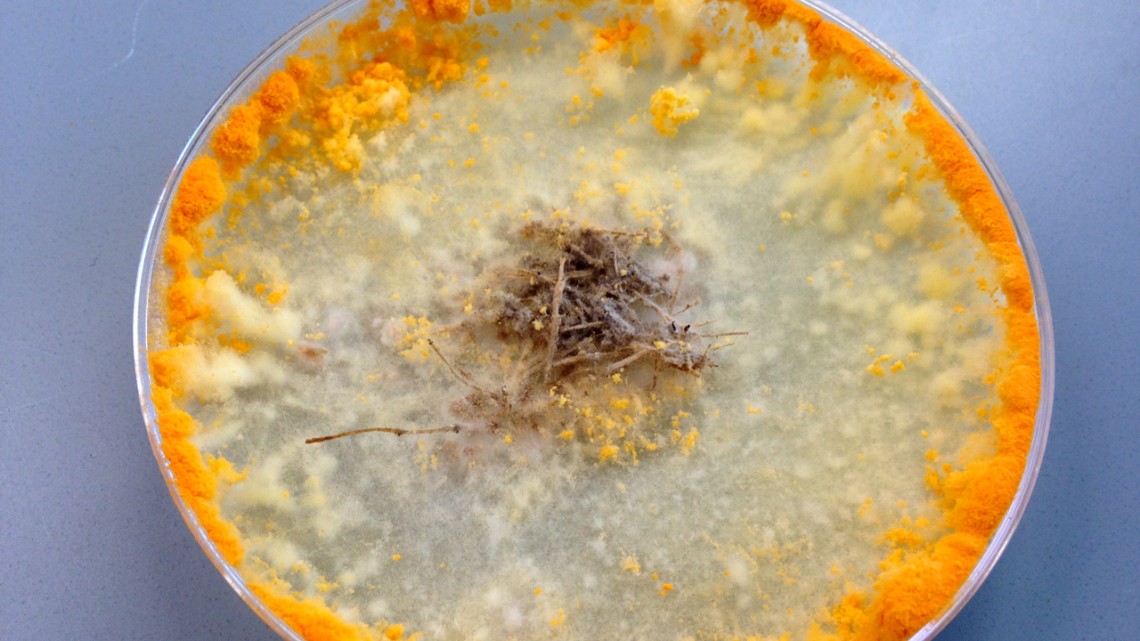
The fungus Neurospora crassa.
Fungal nutrient sensing could shed light on obesity, cancer
By Krisy Gashler
Lori Huberman, assistant professor in the School of Integrative Plant Science’s Plant Pathology and Plant-Microbe Biology Section, has been awarded a $1.9 million grant from the National Institutes of Health to study how fungi sense and use nutrients, basic research with potential applications for treatment of cancer, obesity, Type 2 diabetes and fungal infections.
Humans, plants, animals and fungi are all eukaryotes (organisms made up of cells with distinct nuclei), and past research in fungi has led to breakthroughs in treatment and prevention of myriad human illnesses. The majority of fungal research has been done with Saccharomyces cerevisiae, better known as nutritional yeast; roughly 20% of all biopharmaceuticals are derived from S. cerevisiae, including insulin and the vaccines for hepatitis and Human papillomavirus. S. cerevisiae is relatively affordable and easy to manipulate, but it has a very narrow diet, only eating simple sugars, which limits its usefulness in understanding nutrient sensing in organisms with more complex diets, Huberman said.
To better understand how eukaryotes sense and use nutrients, Huberman will study two distantly related fungi that draw on a more diverse array of food sources: Rhodosporidium toruloides, a yeast that consumes a broader variety of sugars and other carbohydrates, and Neurospora crassa, a fungus that can withstand high heat and consumes dead plant material after forest fires.
“These two fungi are very distantly related, separated by hundreds of millions of years of evolution,” Huberman said. “By studying similar questions in these two distantly related organisms, we can ask whether the mechanisms that we’re identifying are happening in both organisms, which might imply that they’re happening among all eukaryotes, including humans. And if their mechanisms are distinct, then those pathways might be potential targets for treating fungal disease.”
In humans, inaccurate nutrient sensing can lead to Type 2 diabetes and obesity. Nutrient sensing is also significant in cancer, as cancer cells absorb nutrients much more quickly than healthy cells as they grow and spread. Some chemotherapies already take advantage of this dynamic by changing available nutrients or preventing cancerous cells from taking up certain nutrients, Huberman said.
“Our hope is that by finding new pathways by which cells are regulating growth, and by better understanding how they are integrating signals about how much nitrogen, carbon and phosphate are around, this could potentially help with finding new treatment for slowing the growth of cancer cells,” she said.
Huberman will be collaborating with researchers at the University of California, Berkeley, who have developed a library of 300,000 Rhodosporidium mutants, each tagged with a unique DNA barcode. By exploring how different mutants respond to various nutrient conditions, Huberman and her colleagues will be able to test hypotheses about gene function. As part of the five-year NIH grant, Huberman’s lab plans to create a similar library of Neurospora variants at Cornell.
The research is being supported by NIH’s National Institute of General Medical Sciences, which “supports basic research that increases understanding of biological processes and lays the foundation for advances in disease diagnosis, treatment and prevention.”
Krisy Gashler is a freelance writer for the College of Agriculture and Life Sciences.
Media Contact
Get Cornell news delivered right to your inbox.
Subscribe
